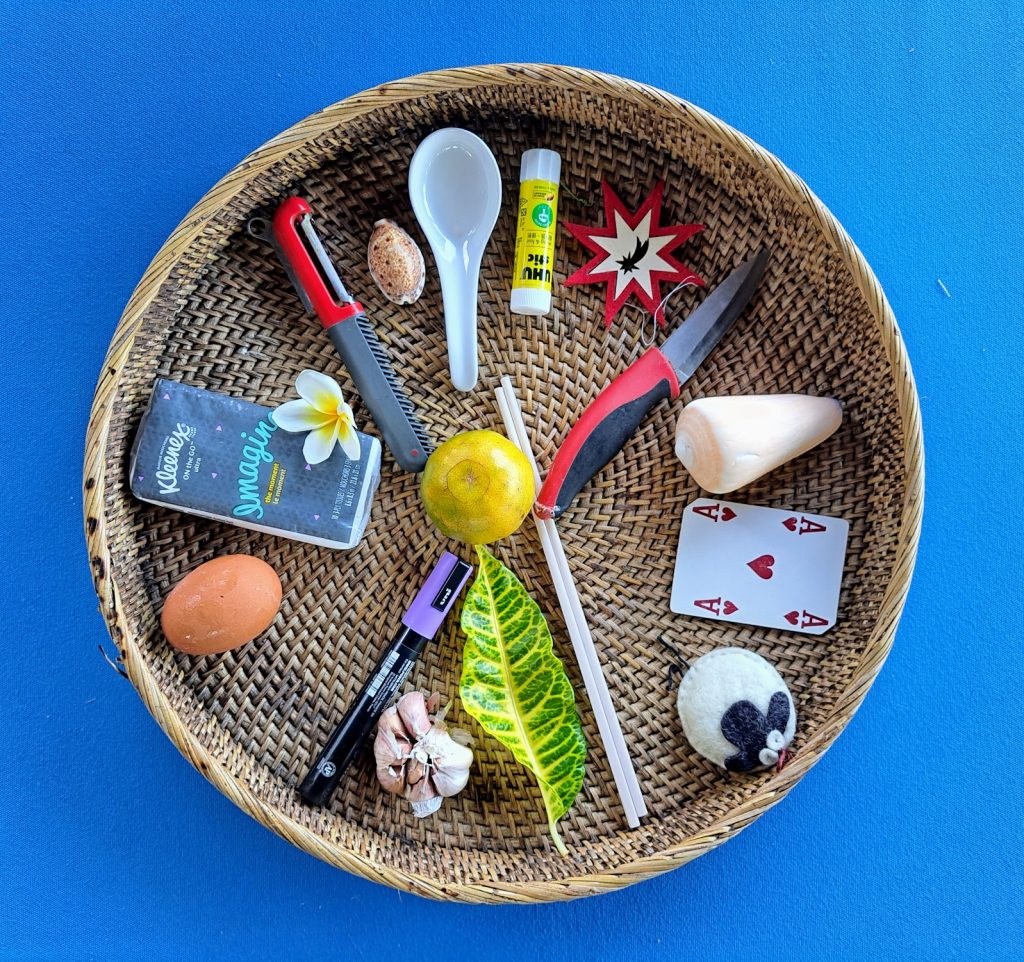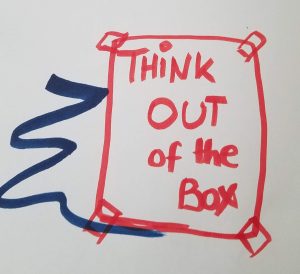6 Getting to Know You: Metaphors for Self
There are many different ways to help a group of people get to know each other and create bonds of trust. Humans often think in symbols and it can help participants to talk about themselves when they are using an object or image that illustrates some aspect of their current reality.

PURPOSE:
Participants will use an object as a metaphor for themselves in order to build capacity to reflect, self-disclose, think metaphorically and deepen group understanding and trust.
Learning Objectives
Participants will:
- Reflect on who they are at this particular point in their lives.
- Express themselves using a metaphor.
- Build listening skills by paying close attention to individual stories and group themes.
Activity Directions
- Find objects: Gather a random assortment of objects found in nature, your office or home. There should be more than enough for each person to choose one object.
- Set-Up: Arrange the room so that chairs are in a circle or people are sitting on the carpet in a circle. Place the objects in the middle.
- Individuals choose object: Ask people to look at the variety of objects and choose one thing that represents who they are right now.
- Individuals share the meaning of their object : Go around the circle with each person introducing themself and why they chose their object. Why were they drawn to this particular object? How does it represent them? How is it a symbol for who they are or how they are feeling right in this moment? The facilitator might want to go first to model a response and set the tone for self-disclosure.
Examples
Slava: “I chose the egg because I feel like I am at the start of a new part of my life. I don’t know what is going to hatch or emerge, but there is a sense of potential and I feel some excitement about new beginnings.”
Olivia: “I chose this glue stick because I see myself as someone who is often a peacemaker. I am often the one who helps my family and friends to connect with each other when there are problems. I feel like I am the glue.”
Abdullah: “I chose the knife because I am working so hard to be focussed this year. I want to be like a knife and cut away the things that distract me and keep me bound to my old habits. The knife is for clarity and purpose and moving forward in my life with precision.”
Wayan: “I chose the shell because it reminds me of the ocean. When I am stressed or sad, I close my eyes and think of the waves and the endless water. It helps calm me. The shell represents me because it is complex and the creature is hidden inside. Sometimes it takes people a while to get to know me, because I have a shell, but it is worth it.”
5. Full Group Discussion:
- What was it like for you to talk about yourself using your symbolic object?
- Did anyone notice any common themes in the group as a whole?
- Were there objects that have symbolism or meanings unique to different cultural backgrounds?
- Any other insights or comments on what you learned about yourself or your group members from this activity?
Materials:
- Random objects arranged in a flat basket or laid out on a plain piece of material.
Variations and Online Adaptations:
1. Start the workshop with a mindful walk outside in nature. At the end of the walk, ask participants to wander aimlessly for five minutes and come back to the group circle with an object they have found that represents them.
2. For on-line workshops, ask the participants to look around the room they are in and find one object that represents them. Share objects in the full group or in Zoom or other platform break-out rooms.
3. Facilitator can have a power point slide with a variety of photographs of scenes and objects. Students can each choose one image that represents them and explain why they chose that object.
4. Facilitator can present six images of different kinds of weather and participants can choose which weather system represents their current emotional state.
Case Study: Neuroscience of Wellbeing Course During the Coronavirus Pandemic
In 2020 when universities were closed and everyone returned to their home communities, my colleague, Safeera Jaffer, and I decided to offer an online course to students that focussed on how they could maintain health and wellbeing while living in lock- down situations in their homes in Tajikistan, Pakistan, Kyrgyzstan, Kazakhstan and Russia. At our first session we asked students to look around their family homes for an object that represented how they were coping with lockdown.
Here are a couple examples of their responses:
- “I chose this plant that sits in my window sill because it is still growing and trying to survive even though its world is small.”
- “I think that this book represents me. I am escaping into novels. When there are conflicts in my family, I just try and find a place to read and forget what is happening.”
It was an interesting way to get to know each other and check-in with how people were managing the very strange situation we were all living in.
3. It is also possible to not offer a choice of objects. Participants can use brainstorming and creative thinking skills to describe how a random object suggests answers to a posed problem:
Case Study: Design thinking for generating fresh ideas and prototypes
At a Healthy Minds|Healthy Campus summit in Vancouver, a team from Ontario facilitated a session on how to use “Design Thinking” to approach mental health issues on post-secondary campuses. Stage three of the design process asks people to “Ideate: Challenge Assumptions and Create Ideas.” At this point, participants were asked to reach under their chair and find an object. At meeting tables, group members went around the circle explaining how their object could suggest an answer to the question; “What needs to happen for universities to meet the mental health needs of students and faculty?”
The use of random objects helped people generate “out-of-the-box” ideas about how to approach a challenging issue. It extended the brainstorming process into new and novel ways of approaching a problem. After people generated many ideas for approaching an issue, the group looked for themes and then created a prototype that was used to experiment with a new approach to a complex problem.
Example Responses:
“My object is a plastic spider. It suggests that healthy university campuses can continue to build strong webs and networks of support in residences, classrooms and services. We need to build the web carefully, ring by ring, so people can access help from any point.”
“My object is a puzzle piece. It makes me think that there are many people in communities and on campus that have a piece of the puzzle to mental health and wellbeing, but we need to create ways for different departments and services to meet each other and understand how the pieces fit together to create a more cohesive overall picture.”

